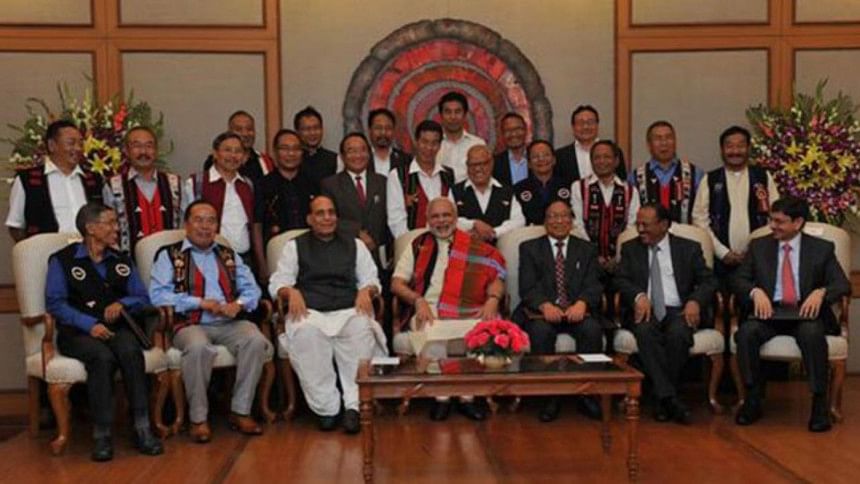The Naga Peace Accord and the challenges ahead

The "historic Peace Accord", signed between the National Socialist Council of Nagaland - led by Isaac Swu and Thuingaleng Muivah - popularly known as the NSCN(IM) and the Government of India in New Delhi on August 3, after 80 rounds of peace negotiations, expanding over 16 years, is expected to herald a new era of peace in the North Eastern region.
Prime Minister Narendra Modi has said, "Today, we mark not merely the end of a problem, but the beginning of a new future" and assured that India would be a "partner as you restore your pride and prestige." Terms like 'pride', 'prestige', 'honour' and 'dignity' were used when Muivah spoke at the ceremony, indicating the deep-seated feeling of the Nagas and their larger stake in the political system that recognises their unique culture and history and protecting them from the integrating tendency of the nation-state. Nineteen other top leaders from various organisations in Nagaland were present when the peace Accord was signed, reflecting a broad consensus.
What has generated controversy around the Peace Accord is that the terms and condition have not yet been made public. Even though the government terms this as a Peace Accord, Muivah described the accord as a "framework agreement" for political settlement of the Naga issue and recognition of the "unique history and situation of the Nagas." This, thus, creates doubts regarding the nature of the Peace Accord. The secrecy surrounding the Accord is also creating unnecessary apprehensions among various other major stakeholders. The agreement has ruled out the redrawing of boundaries of the present states in North East, which is a major assurance to other stakeholders. The NSCN (IM) has given up their demand of unifying all the Naga areas under a single state to create a greater Nagalim – a demand opposed tooth and nail by Indian states of Manipur, Assam and Arunachal Pradesh that have a significant Naga population. The NSCN has declared a ceasefire since 1997. The Government of India had also extended the ceasefire with the National Socialist Council of Nagaland (Khole-Kitovi).
The Accord has brought in sharp criticism from the state governments. In a joint press conference held in New Delhi, the chief ministers of the Congress-ruled North Eastern states severely criticised the manner in which the Peace Accord was signed, without taking the chief ministers of the states into confidence, despite the prime minister's emphasis on "cooperative federalism". The government, though, spoke to the Governor of Nagaland and intimated the opposition parties regarding the impending Peace Accord. The negotiation was piloted by the Prime Minister's Office and the main interlocutor was the former Chairman of Joint Intelligence Committee, R.N. Ravi. Earlier, Ravi had alleged that the ceasefire agreement with Khaplang was negated by the Home Ministry in March without consulting him. The challenge is to bring major opposing factions, notably the NSCN-K led by S.S. Khaplang, on board and have them accept the Accord, which would be a pre-requisite for peace.
In March this year, the NSCN (Khaplang) called off the ceasefire, ostensibly protesting his group's exclusion from the talks. It expelled the pro-talk lobby within the NSCN-K, Wangtin Naga and P. Tikhak, who supported the ceasefire in the meeting of the Cease Fire Supervisory Board (CFSB) against Khaplang's decision to call it off. After their expulsion, the two formed the NSCN (Reformation). In 2011, Khaplang had also expelled the group's General Secretary N. Kitovi Zhimomi and Commander in Chief Khole Konyak, two senior leaders, alleging that their dedication to the Naga cause was "doubtful" and blamed them for "celebrating unification anniversary" when cadres were being killed by security forces. This division led to infightings between the cadres of Khaplang and Kitovi-Khole supporters. After calling off the ceasefire in March, Khaplang moved to Myanmar and reportedly masterminded the attack against the Indian military convoy, killing 18 soldiers and resulting in a cross-border raid.
However, Khaplang has expanded his network and has given shelter to other rebel groups from the North East in Sagaing, Myanmar, where he is based. He has signed a peace deal with the Myanmar military in April 2012 and is permitted to remain there. The Khaplang group is part of nine insurgent groups, which includes the Paresh Barua faction of the United Liberation Front of Assam (ULFA) and the Kamtapur Liberation Organisation (KLO). Together they formed an umbrella organistation, the United Liberation Front of Western South East Asia (ULFWSEA). However, there are reports that Khaplang called off the ceasefire after coming under the influence of Paresh Baruah who is suspected to be in China.
By concluding an Accord with the NSCN-IM, the Indian government has taken advantage of the existing fault lines between the Myanmarese Nagas, led by Khaplang, and the Indian Nagas, led by Issak-Muivah. However, for greater peace of the region, Khaplang must be taken on board. Presidents of Naga Hoho, which is considered as an apex body of Naga tribes, and the Eastern Nagaland People's Organisation (ENPO) are planning to travel to Myanmar after August 15 to persuade Khaplang to re-impose ceasefire for greater peace. New Delhi has cleared their travel. It is yet to be seen whether Khaplang will rethink his strategy and join hands with its one time comrade and now arch-rival NSCN (IM) in heralding a new era of peace in the region that has kept economic activities hostage, resulting in the widening of criminal networks which is benefitting from the insurgency at the cost of people.
The writer is Research Fellow, IDSA.

 For all latest news, follow The Daily Star's Google News channel.
For all latest news, follow The Daily Star's Google News channel. 



Comments